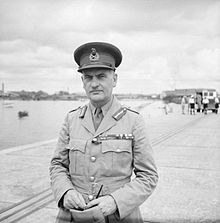Henry Pownall
Sir Henry Pownall | |
|---|---|
 Lieutenant General Sir Henry Pownall, 1941. | |
| Born | 19 November 1887 London, England |
| Died | 10 June 1961 (aged 73) London, England |
| Allegiance | United Kingdom |
| Service/ | British Army |
| Years of service | 1906–1945 |
| Rank | Lieutenant-General |
| Service number | 3553 |
| Unit | Royal Field Artillery Royal Artillery |
| Commands held |
|
| Battles/wars |
|
| Awards |
|
| Relations |
|
Early career
Henry Royds Pownall was born in London on 19 November 1887, the second son of Charles Assheton Whately Pownall and his wife, Dora Bourne Royds. His brother was Sir Assheton Pownall and his Grandfather The Ven. Assheton Pownall Archdeacon of Leicester. His father Charles Pownall was a consulting engineer with the Japanese railways, and Pownall lived in Japan from when he was three until he was eight years old. He received his education at Rugby School and Royal Military Academy, Woolwich.[1] and was commissioned as a second lieutenant in the Royal Field Artillery on 20 December 1906.[2] He began his military service with the Royal Horse Artillery, where he was stationed at Lucknow with U Battery.[3] He was promoted to lieutenant on 20 December 1909.[4]
First World War
During the
Interbellum
On 10 December 1918, Pownall married Lucy Louttit, the widow of Captain John Gray, a
Pownall attended the
Pownall attended the Imperial Defence College in 1932, and, following this, he held a series of staff appointments, serving as the Military Assistant Secretary for the Committee of Imperial Defence from 1933 to 1935, then as Deputy Secretary for the Committee of Imperial Defence in 1936.[13][12] His rank of lieutenant-colonel became substantive on 31 January 1935,[17] and he was promoted to colonel on 1 May 1935, with his seniority backdated to 1 January 1932.[18] From 1936 to 1938,[12] he was Commandant of the Royal School of Artillery, with the rank of brigadier from 15 September 1936.[19] As the threat of war grew, he was Director of Military Operations and Intelligence in the War Office from 1938 to 1939.[12][13] He was promoted to major-general on 26 March 1938.[20]
Second World War

Britain entered the war on 3 September 1939, and the following day Pownall was appointed Chief of General Staff of the
Pownall then assumed the position of inspector general for the recently created
Pownall became commander-in-chief of the

After ABDACOM was dissolved in February 1942, Pownall assumed the role of
Pownall was made a
Post war
After the war, Pownall was chairman of
Pownall died in London on 10 June 1961, aged 73.[1] His papers are in the Liddell Hart Centre for Military Archives.[13]
Notes
- ^ doi:10.1093/ref:odnb/35597. (Subscription or UK public library membershiprequired.)
- ^ "No. 27986". The London Gazette. 15 January 1907. p. 326.
- ^ Hart 1911, p. 229.
- ^ Hart 1911, p. 213.
- ^ "No. 28960". The London Gazette (1st supplement). 30 October 1914. p. 8862.
- ^ "No. 28960". The London Gazette (1st supplement). 30 October 1914. p. 8862.
- ^ British Army List. 1922. p. 581. Retrieved 17 April 2023.
- ^ "No. 30077". The London Gazette (1st supplement). 18 May 1917. p. 4871.
- ^ "No. 30421". The London Gazette (1st supplement). 7 December 1917. p. 12919.
- ^ "No. 30450". The London Gazette (1st supplement). 28 December 1917. p. 25.
- ^ Bond 1972, p. ix.
- ^ a b c d e f g h Smart 2005, pp. 254–255.
- ^ a b c d e "Pownall, Lt Gen Sir Henry Royds (1887-1961)". Liddell Hart Centre for Military Archives. Retrieved 17 April 2023.
- ^ "No. 33344". The London Gazette. 3 January 1928. p. 45.
- ^ "No. 33823". The London Gazette. 6 May 1932. p. 2959.
- ^ "No. 33823". The London Gazette. 6 May 1932. p. 2958.
- ^ "No. 34129". The London Gazette. 1 February 1935. p. 769.
- ^ "No. 34161". The London Gazette (1st supplement). 17 May 1935. p. 3220.
- ^ "No. 34324". The London Gazette. 18 September 1936. p. 6005.
- ^ "No. 34497". The London Gazette. 29 March 1938. p. 2087.
- ^ Mead 2007, p. 359.
- ^ "No. 34680". The London Gazette (1st supplement). 12 September 1939. p. 6239.
- ^ "No. 34893". The London Gazette (1st supplement). 10 October 1941. p. 4247.
- ^ "No. 35305". The London Gazette (1st supplement). 10 October 1941. p. 5900.
- ^ "No. 35305". The London Gazette (1st supplement). 10 October 1941. p. 5911.
- ^ "No. 35305". The London Gazette (1st supplement). 10 October 1941. p. 5933.
- ^ Mead 2007, p. 361.
- ^ "No. 35509". The London Gazette (1st supplement). 31 March 1942. p. 1497.
- ^ "No. 35807". The London Gazette. 1 December 1942. p. 5258.
- ^ "No. 35863". The London Gazette (1st supplement). 12 January 1943. p. 323.
- ^ Mead 2007, p. 364.
- ^ "No. 36866". The London Gazette (1st supplement). 10 January 1945. p. 3.
- ^ "No. 37254". The London Gazette (1st supplement). 10 January 1945. p. 4470.
References
- OCLC 817045350.
- OCLC 54550813.
- Hart, Henry George (1911). Hart's Annual Army List, Special Reserve List, and Territorial Force List (PDF). Vol. LXXII. London: John Murray. Retrieved 17 April 2023.
- Mead, Richard (2007). Churchill's Lions: a biographical guide to the key British generals of World War II. ISBN 978-1-86227-431-0.
- Smart, Nick (2005). Biographical Dictionary of British Generals of the Second World War. ISBN 1844150496.
